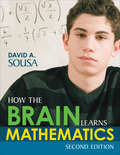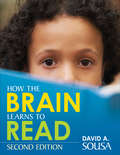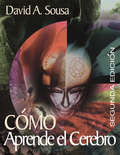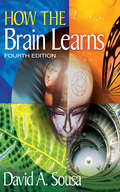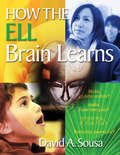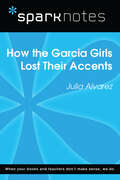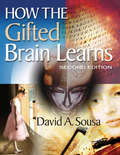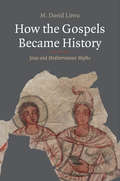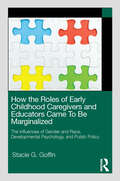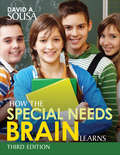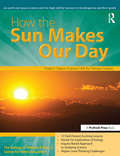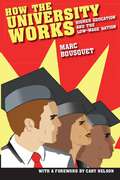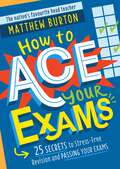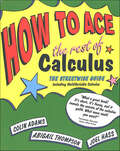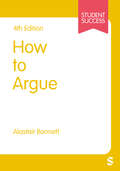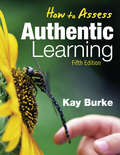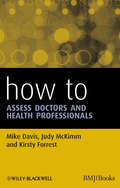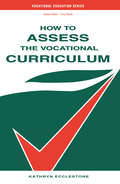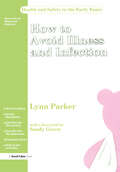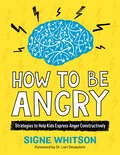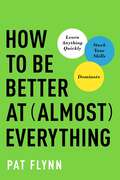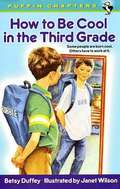- Table View
- List View
How the Brain Learns Mathematics
by Dr David A. SousaTo reach all your math students, use your brain—and theirs, too! This updated bestseller takes readers to the next level with new brain-friendly strategies backed by the latest research and even more ways to seamlessly incorporate what you learn about your students’ developing minds into your math classroom. Discover the cognitive mechanisms for learning math, explore factors that contribute to learning difficulties, and follow a four-step teaching model that relates classroom experience to real-world applications. Features include: New strategies for motivating adolescents Integration of the arts into mathematics instruction New information on how technology affects attention and memory Expanded sections on number sense and ELL instruction More than 160 new references
How the Brain Learns to Read
by Dr David A. SousaA modern classic, updated for today’s classroom needs No skill is more fundamental to our students’ education than reading. And no recent book has done more to advance our understanding of the neuroscience behind this so-critical skill than David Sousa’s How the Brain Learns to Read. Top among the second edition’s many new features are: Correlations to the Common Core State Standards A new chapter on how to teach for comprehension Much more on helping older struggling readers master subject-area content Ways to tailor strategies to the unique needs of struggling learners Key links between how the brain learns spoken and written language
How the Brain Learns/Como Aprende el Cerebro
by Dr David A. SousaSegunda EdicionThe powerful best-seller on brain research and education is available in a Spanish Language Edition. Cómo Aprende el Cerebro siempre se ha concentrado en brindar información que puede ayudar a los educadores a tomar los descubrimientos sobre las funciones cerebrales y transformarlos en lecciones y actividades prácticas para la clase. La nueva segunda edición sigue incluyendo datos básicos acerca del cerebro que pueden ayudar a los estudiantes a aprender, brinda información sobre la manera en que el cerebro procesa información y da sugerencias para maximizar la retención, usando "los momentos de mínima retención." siempre se ha concentrado en brindar información que puede ayudar a los educadores a tomar los descubrimientos sobre las funciones cerebrales y transformarlos en lecciones y actividades prácticas para la clase. La nueva segunda edición sigue incluyendo datos básicos acerca del cerebro que pueden ayudar a los estudiantes a aprender, brinda información sobre la manera en que el cerebro procesa información y da sugerencias para maximizar la retención, usando "los momentos de mínima retención."
How the Brain Learns: A Multimedia Kit For Professional Development
by Dr. David A. SousaGive your brain knowledge a boost David A. Sousa continues his successful tradition of translating current research findings into effective classroom strategies and activities in this new version of his bestselling text. The fourth edition integrates the most current developments in neuroscience, education, and psychology to inform your instruction and enhance your students&’ learning. Included are: New information on memory systems Findings on how technology affects the brain Information on brain organization and learning, and hemispheric specialization Evidence that supports the value of the arts in improving cognitive processing and creativity More than 150 new or updated references and an expanded index
How the ELL Brain Learns
by Dr David A. SousaRaise your ELL success quotient and watch student achievement soar! How the ELL Brain Learns combines current research on how the brain learns language with strategies for teaching English language learners. Award-winning author and brain research expert David A. Sousa describes the linguistic reorganization needed to acquire another language after the age of 5 years. He supplements this knowledge with immediately applicable tools, including: A self-assessment pretest for gauging your understanding of how the brain learns languages Brain-compatible strategies for teaching both English learners across content areas An entire chapter about how to detect English language learning problems
How the Earth Works: 60 Fun Activities for Exploring Volcanoes, Fossils, Earthquakes, and More
by Michelle O'Brien-PalmerEarth science comes alive for children 6 to 9 through 60 engrossing games, activities, and experiments. Kids “core sample” a filled cupcake and discover plate tectonics by floating graham cracker continents on a molten mantle of molasses. They learn how heat changes rocks by seeing how separate ingredients disappear when they bake Rice Krispie Treats. More activities show what causes earthquakes and what kinds of buildings resist their force. Growing sugar and salt crystals, “fossilizing” plastic insects, and modeling a variety of volcanoes add to the learning and the fun. Eight of the activities are tasty as well as informative. Silly songs help children remember new words and concepts, and a resource section gives inexpensive sources for rocks, minerals, and fossils. All the projects have been tested in homes and schools to make sure they are safe, effective, and fun.
How the Garcia Girls Lost Their Accents (SparkNotes Literature Guide Series)
by SparkNotesHow the Garcia Girls Lost Their Accents (SparkNotes Literature Guide) by Julia Alvarez Making the reading experience fun! Created by Harvard students for students everywhere, SparkNotes is a new breed of study guide: smarter, better, faster. Geared to what today's students need to know, SparkNotes provides: *Chapter-by-chapter analysis *Explanations of key themes, motifs, and symbols *A review quiz and essay topicsLively and accessible, these guides are perfect for late-night studying and writing papers
How the Gifted Brain Learns
by Dr David A. SousaIdentify, understand, and engage the full range of gifted learners with practical, brain-compatible classroom strategies! The updated edition of Sousa’s bestseller translates the latest neuroscientific findings into practical strategies for engaging gifted and talented learners. Individual chapters are dedicated to talents in language, math, and the arts, and offer instructional applications for both elementary and secondary classrooms. This reader-friendly guide uncovers: How the brains of gifted students are different How to gauge if gifted students are being adequately challenged How to identify students who are both gifted and learning disabled How to better identify gifted minority students
How the Gospels Became History: Jesus and Mediterranean Myths (Synkrisis)
by M. David LitwaA compelling comparison of the gospels and Greco-Roman mythology which shows that the gospels were not perceived as myths, but as historical records Did the early Christians believe their myths? Like most ancient—and modern—people, early Christians made efforts to present their myths in the most believable ways. In this eye-opening work, M. David Litwa explores how and why what later became the four canonical gospels take on a historical cast that remains vitally important for many Christians today. Offering an in-depth comparison with other Greco-Roman stories that have been shaped to seem like history, Litwa shows how the evangelists responded to the pressures of Greco-Roman literary culture by using well-known historiographical tropes such as the mention of famous rulers and kings, geographical notices, the introduction of eyewitnesses, vivid presentation, alternative reports, and so on. In this way, the evangelists deliberately shaped myths about Jesus into historical discourse to maximize their believability for ancient audiences.
How the Roles of Early Childhood Caregivers and Educators Came To Be Marginalized: The Influences of Gender and Race, Developmental Psychology, and Public Policy
by Stacie G. GoffinThis book examines the interactions of gender and race, developmental psychology, and public policy and how, collectively, they influenced the marginalization of early childhood caregivers’ and educators’ roles. In order to learn how their roles came to be both externally and internally marginalized—in public esteem, research attention, compensation, and valuation—Goffin traces the origins of the early childhood care and education field and its evolution over time. Also taken into account is the influence of the early childhood care and education field’s insufficient attention to practitioners’ emerging stature. Chapter by chapter, the book (Left Behind for short) calls attention to the historical influences of its racial and gender context, its long-standing reliance on developmental psychology, and its dependence on public policy, along with how, when intertwined, these influences led to the marginalization of early childhood caregivers and educators’ role, which helped shape early childhood care and education as a field of practice. This work is ideal for early childhood care and education’s undergraduate and graduate faculty, its undergraduate and graduate students, early childhood care and education policy advocates, those in state department administrative roles, those who self-identify as change agents, plus early childhood caregivers and educators who want to learn more about their history.
How the Special Needs Brain Learns
by Dr David A. SousaTeaching students with learning challenges just got easier with this groundbreaking guide! If you’ve been searching for effective strategies to meet the needs of learning challenged students, look no further. In this newly revised and updated third edition, expert David A. Sousa addresses the causes of common learning disabilities and provides alternative instructional strategies to ensure learning occurs. Discover cutting-edge brain research to help you: Effectively instruct students with ADHD, LD, dyslexia, autism, and more Utilize assistive technologies to remove barriers to learning Differentiate instruction in speech, reading, writing, and mathematics
How the Special Needs Brain Learns
by Dr David A. SousaTeaching students with learning challenges just got easier with this groundbreaking guide! If you’ve been searching for effective strategies to meet the needs of learning challenged students, look no further. In this newly revised and updated third edition, expert David A. Sousa addresses the causes of common learning disabilities and provides alternative instructional strategies to ensure learning occurs. Discover cutting-edge brain research to help you: Effectively instruct students with ADHD, LD, dyslexia, autism, and more Utilize assistive technologies to remove barriers to learning Differentiate instruction in speech, reading, writing, and mathematics
How the Sun Makes Our Day: An Earth and Space Science Unit for High-Ability Learners in Grades K-1
by Clg Of William And Mary/Ctr Gift EdHow the Sun Makes Our Day, an Earth and space science unit for grades K-1, engages students in investigations and observations about the sun as a source of light and energy, the nature of shadows, man-made sources of energy, and the need for humans to conserve natural resources.How the Sun Makes Our Day was developed by the Center for Gifted Education at The College of William and Mary to offer advanced curriculum supported by years of research. The Center's materials have received national recognition from the United States Department of Education and the National Association for Gifted Children, and they are widely used both nationally and internationally.Each of the books in this series offers curriculum that focuses on advanced content and higher level processes. The science units contain simulations of real-world problems, and students experience the work of real science by using data-handling skills, analyzing information, and evaluating results. The mathematics units provide sophisticated ideas and concepts, challenging extensions, higher order thinking skills, and opportunities for student exploration based on interest. These materials are a must for any teacher seeking to challenge and engage learners and increase achievement.Grades K-1
How the University Works: Higher Education and the Low-Wage Nation (Cultural Front #3)
by Cary Nelson Marc BousquetUncovers the labor exploitation occurring in universities across the countryAs much as we think we know about the modern university, very little has been said about what it's like to work there. Instead of the high-wage, high-profit world of knowledge work, most campus employees—including the vast majority of faculty—really work in the low-wage, low-profit sphere of the service economy. Tenure-track positions are at an all-time low, with adjuncts and graduate students teaching the majority of courses. This super-exploited corps of disposable workers commonly earn fewer than $16,000 annually, without benefits, teaching as many as eight classes per year. Even undergraduates are being exploited as a low-cost, disposable workforce. Marc Bousquet, a major figure in the academic labor movement, exposes the seamy underbelly of higher education—a world where faculty, graduate students, and undergraduates work long hours for fast-food wages. Assessing the costs of higher education's corporatization on faculty and students at every level, How the University Works is urgent reading for anyone interested in the fate of the university.
How to Ace Your Exams: 25 secrets to stress-free revision and passing your exams
by Matthew BurtonACE your exams and banish study stress with this handy guidebook from inspirational headteacher and star of Channel 4's Educating Yorkshire, Mr Matthew Burton.Getting ready for exams can be A LOT - but with the right preparation and these incredible tips, tricks and techniques, you can expel exam anxiety and set yourself up for success.This inspirational handbook includes 25 super sections on how to master your topic, set great habits, memorise information FAST, optimise your performance, keep calm and stress-free and, when exams are all over, know exactly what to do next.From getting to grips with your subject and hitting important milestones, to dealing with anxiety and preparing for the big day, this vital handbook will help you shake off study stress and set yourself up for success. How to Ace Your Exams is the only book you need to buy to help you pass with flying colours.
How to Ace the Rest of Calculus: The Streetwise Guide (How to Ace)
by Joel Hass Colin Adams Abigail ThompsonThe sequel to How to Ace Calculus, How to Ace the Rest of Calculus provides humorous and highly readable explanations of the key topics of second and third semester calculus-such as sequences and series, polor coordinates, and multivariable calculus-without the technical details and fine print that would be found in a formal text.
How to Argue (Student Success)
by Alastair BonnettDo you want to get better at developing your argument, but don′t know where to start? This book breaks down different types of argument, from writing to presenting and exam technique. It′s ideal for students of all levels and of all study areas, making this a go-to text for everyone. Key features include: - Chapter objectives and key topics to ensure it′s the right chapter for you - Tips, exercises and useful phrases to apply the content to your learning - A glossary and further reading to broaden your arguing technique Student Success is a series of essential guides for students of all levels. From how to think critically and write great essays to boosting your employability and managing your wellbeing, the Student Success series helps you study smarter and get the best from your time at university.
How to Argue (Student Success)
by Alastair BonnettDo you want to get better at developing your argument, but don′t know where to start? This book breaks down different types of argument, from writing to presenting and exam technique. It′s ideal for students of all levels and of all study areas, making this a go-to text for everyone. Key features include: - Chapter objectives and key topics to ensure it′s the right chapter for you - Tips, exercises and useful phrases to apply the content to your learning - A glossary and further reading to broaden your arguing technique Student Success is a series of essential guides for students of all levels. From how to think critically and write great essays to boosting your employability and managing your wellbeing, the Student Success series helps you study smarter and get the best from your time at university.
How to Assess Authentic Learning
by Kathleen B. BurkeCreate assessments that meet state standards and target students’ learning needs! In this revised edition of her bestseller, Kay Burke provides a wide range of easy-to-implement alternative assessments that address today’s accountability requirements. Designed for use across all content areas, these formative assessments are rooted in the language of state standards and emphasize differentiating instruction to meet students’ diverse learning needs. Updated research and examples help K–12 teachers: Build Response to Intervention checklists for struggling students Develop unit plans using differentiated learning and assessment strategies Create portfolios that emphasize metacognition Design performance tasks that motivate and engage students Construct rubrics that describe indicators of quality work Create tests that focus on higher-order thinking skills
How to Assess Doctors and Health Professionals
by Mike Davis Judy Mckimm Kirsty ForrestThis important book offers an introduction to the theory and the varying types of assessment for health care professionals. The book includes information on such topics as Where have work based assessments come from?; Why do we have different parts to the same exam like MCQs and OSCEs?; How do colleges decide who has passed or not?; Why can people pick their own assessors for their MSF?; The role of formative assessment Portfolios and their value. The book avoids jargon, is clear and succinct, and gives the pros and cons of the different assessment processes.
How to Assess the Vocational Curriculum (Vocational Education Ser.)
by Ecclestone, KathrynUsing case studies from schools and colleges, this book outlines different forms of assessment, highlights their purposes, and provides practical guidelines to their implementation.
How to Avoid Illness and Infection
by Lynn ParkerIf you work in Early Years settings it is essential that you are well informed and aware of health and safety issues and procedures that you may face on a day-to-day basis. This book will provide clear, concise and practical information about health and safety, whilst fully translating the legislative documentation that surrounds it to ensure that you meet OFSTED requirements, and that you are fulfilling your obligation in keeping the children under your care safe. Practical advice is offered on issues such as: common childhood infections and the exclusion periods relating to them routine medications records, policies and permissions protective clothing vaccination. Written in accordance with national health and safety standards that have to be achieved at inspection, this is part of a practical series of 'how to' guides that are essential purchases for anyone working in an Early Years setting looking to certify that their nursery environment safe as well as fun.
How to Be Angry: Strategies to Help Kids Express Anger Constructively
by Signe WhitsonChildren and teenagers often struggle to cope with anger, and angry feelings can boil over into aggression and destructive behaviour. This updated and extended resource takes a different approach to anger, teaching children how to be angry effectively, rather than telling them not to be angry at all.Encouraging appropriate anger management through group work and tailored lessons, the book is also accompanied by downloadable additional resources demonstrating the activities and offering adaptations for parents. Suitable for use with children and teenagers aged 5 - 18, this engaging resource will help children to overcome self-destructive patterns of passive, aggressive, and passive aggressive behaviour.
How to Be Better at Almost Everything: Learn Anything Quickly, Stack Your Skills, Dominate
by Pat FlynnMastering one specific skill set might have been the key to success 20 years ago . . . but being the best at a single thing just doesn't cut it in today's global economy. Think about those people who somehow manage to be amazing at everything they do—the multimillionaire CEO with the bodybuilder physique or the rock star with legions of adoring fans. How do they manage to be so great at life? By acquiring and applying multiple skills to make themselves more valuable to others, they've become generalists, able to "stack" their varied skills for a unique competitive edge. In How to Be Better at Almost Everything, bestselling author, fitness expert, entrepreneur, and professional business coach Pat Flynn shares the secrets to learning (almost) every skill, from marketing and music to relationships and martial arts, teaching how to combine interests to achieve greatness in any field. Discover how to: Learn any skill with only an hour of practice a day through repetition and resistance Package all your passions into a single tool kit for success with skill stacking Turn those passions into paychecks by transforming yourself into a person of interest To really get ahead in today's fast-paced, constantly evolving world, you need a diverse portfolio of hidden talents you can pull from your back pocket at a moment's notice. The good news? You don't need to be a genius or a prodigy to get there—you just have to be willing to learn. How to Be Better at Almost Everything will teach you how to make your personal and professional goals a reality, starting today.
How to Be Cool in the Third Grade
by Betsy DuffeyWhen Robbie York is marked as a target by a bully at school, he decides that the only way to survive the third grade is by being cool.
